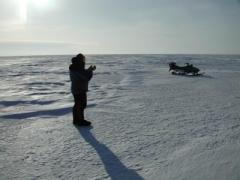
Like icebergs, much of the mass of Arctic ice lies under the surface, making studying its thickness important, as well as the area it covers. Thick, multiyear Arctic sea ice is disappearing, giving way to thin, young ice, according to University of Colorado at Boulder scientists. Credit: James Maslanik, University of Colorado
Nature’s beauty means different things to each of us – but undoubtedly it burns some images onto our souls. Our favourite scenery is less constant than we sometimes suppose, changing from day to day and season to season. But the slowest changes can be the most heartbreaking, eventually robbing us of our favourite landscapes.
Some destructive changes you might consider man-made, for example city sprawl overflowing, and some natural, such as coastal erosion. Landscape losses brought by global warming are a curious mixture of these two – humanity somehow pushing nature into a more savage mood.
In the two and a half years since I started this blog, I’ve often reported on science’s efforts to monitor how climate change is affecting landscapes in different parts of the world. In this week’s blog entry I’ve decided to bring together pictures indicating what their work has told us – you can click on the pictures to read the original blog posts.
With the Arctic changing most rapidly as the world warms, it’s one of the most studied areas, and so its striking environment features highly. But if you look enough at your favourite landscapes, and at when its more regular changes happen, it’s likely you’ll already be able to see the signs of a slow and potentially troublesome revolution in progress.

The marshes of Plum Island Estuary, Massachusetts, are among those predicted by scientists to submerge during the next century under conservative projections of sea-level rise. Credit: Matthew Kirwan, USGS

Lower snow and ice reserves in Asian mountains are set to reduce how much water flows into surrounding rivers and can be used to grow food. As a result the rivers will be able to feed around 65 million fewer mouths by 2050 than at the beginning of the century. Ice and snow melting from the Himalayan mountains, shown here, feeds the Indus and Brahmaputra basins which are expected to suffer the biggest reduction in food output as global warming speeds melting in the mountains. Credit: Kamaljit S. Bawa

Plants and animals living along the coast of the Mackenzie Delta in the Canadian Arctic were devastated by a salt-water flood in 1999, made more severe by climate change. Dead vegetation (brown) killed by the surge is in stark contrast to the vegetation along the edges of waterways that receive regular freshwater (green) and thus survived the damage. Credit: Trevor Lantz, University of Victoria

Sun setting over Sermilik Fjord into which Helheim Glacier forms or “calves” large amounts of icebergs each summer. A recent surge of icebergs produced by Helheim Glacier in Greenland has only been exceeded once in more than a century. Scientists suggest that this establishes a role for climate in calving from glaciers – one that suggests that it will increase as temperatures rise. Credit: Camilla S. Andresen.

Climate change is accelerating erosion in the Arctic, for example through ice-rich permafrost exposure in the coastal zone of Herschel Island, Yukon Territory, Canada, that this scientist is standing in front of. These ice bodies in the permafrost are rapidly eroded by the sea in the coastal zone. Photo: Michael Fritz

However, the Arctic may become more serene, as a slowly warming sea stabilises atmospheric circulation, reducing the frequency of “polar lows” or “Arctic hurricanes”, with the progress of climate change. That will make the area more accessible for activities like shipping or oil exploration. Image © Science/AAAS


June 30, 2012 at 8:49 pm
Are you including the forests in Colorado and New Mexico?
July 6, 2012 at 5:29 pm
I haven’t covered them, Richard. Care to enlighten us on what’s happening there?
July 7, 2012 at 10:40 pm
Grab the movie, “Chasing Ice” to see the glacier changes world-wide.